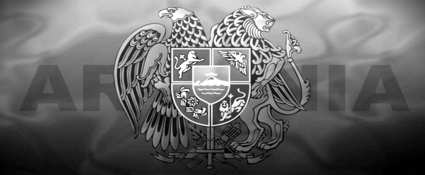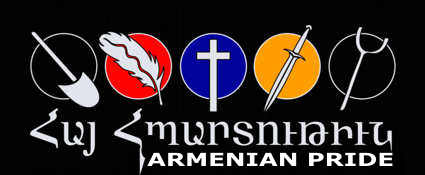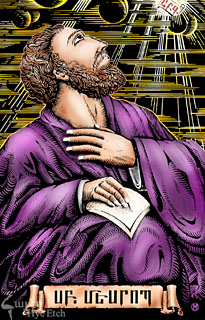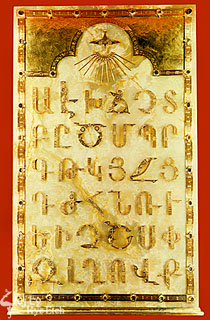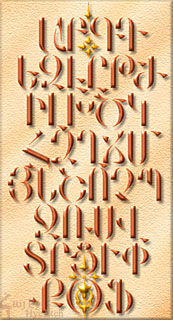|
Armenian
Language
Armenian
is an
Indo-European language spoken in the
Caucasus
mountains and also used by the
Armenian Diaspora.
It is its own independent branch of the
family of the Indo-European languages.
From the modern languages Greek seems to
be the most closely related to
Armenian.
The
Armenian language dates to the early
period of Indo-European differentiation
and dispersion some 5000 years ago, or
perhaps as early as 7,800 years ago
according to some recent research.
Graeco-Armenian hypothesis
Armenian is
regarded by some linguists as a close
relative of
Phrygian.
Many scholars such as Clackson (1994)
hold that
Greek is
the most closely related surviving
language to Armenian. The
characteristically Greek representation
of word-initial
laryngeals
by prothetic vowels is shared by
Armenian, which also shares other
phonological and morphological
peculiarities of Greek. The close
relatedness of Armenian and Greek sheds
light on the
paraphyletic
nature of the
Centum-Satem
isogloss. Armenian also shares major
isoglosses
with Greek; some linguists propose that
the linguistic ancestors of the
Armenians and Greeks were either
identical or in a close contact
relation. However other linguists
including Fortson (2004) comment "by the
time we reach our earliest Armenian
records in the 5th century A.D., the
evidence of any such early kinship has
been reduced to a few tantalizing
pieces."
Iranian
influence
The
Classical Armenian language (often
referred to as
Grabar, literally
"written (language)") imported numerous
words from Middle Iranian languages,
primarily Parthian, and contains smaller
inventories of borrowings from Greek,
Syriac, Latin, and autochthonous
languages such as
Urartian. Middle
Armenian (11th–15th centuries AD)
incorporated further loans from Arabic,
Turkish, Persian, and Latin, and the
modern dialects took in hundreds of
additional words from Modern Turkish and
Persian. Therefore, determining the
historical evolution of Armenian is
particularly difficult because Armenian
borrowed many words from Parthian and
Persian (both Iranian languages) as well
as from Greek.
The large
percentage of loans from Iranian
languages initially led linguists to
classify Armenian as an Iranian
language. The distinctness of Armenian
was only recognized when Hübschmann
(1875) used the comparative method to
distinguish two layers of Iranian loans
from the true Armenian vocabulary. The
two modern literary dialects, Western
(originally associated with writers in
the Ottoman Empire) and Eastern
(originally associated with writers in
the Russian Empire), removed almost all
of their Turkish lexical influences in
the 20th century, primarily following
the Armenian Genocide.
While it contains
many Indo-European roots, its phonology
has been influenced by neighboring
Caucasian languages, so that it shares a
three-way distinction between voiceless,
voiced, and ejective stops and
fricatives.
Armenian was
historically split in to two
vaguely-defined primary dialects:
Eastern Armenian, the form spoken in
modern-day Armenia, and Western
Armenian, the form spoken by Armenians
in Anatolia. After the
Armenian Genocide,
the western form was primarily spoken
only by those belonging to the
diaspora.
Armenian is
written in the
Armenian Alphabet, created by
Saint
Mesrop Mashtots
in 406 AD.
The Armenians are
a predominantly Christian ethnic group,
primarily of the
Armenian Church.
Whether Armenians are Europeans or not
is a bone of contention, as the people
of
Caucasia
have become increasingly disregarded as
being Europeans over the past couple of
centuries. This process was arguably
accelerating as the term "European"
increasingly is being used to refer to
citizens of the
European Union
rather than peoples of ethnic European
origins, but the recent (2004) inclusion
of Armenia in the EU "New Neighborhood",
which is expected to lead to membership
in the long term will once again swing
the pendulum in the direction of Europe.
Eastern Armenian
Eastern Armenian people,
and the dialect are
basically those
Armenians and the
dialects they speak
which originated in the
Russian and Persian
Empires (basically, the
the former USSR and
Iran). Eastern Armenian
is still written in the
original spelling system
invented by Mesrop
Mashtots
by Iranian Armenians,
but in the former USSR a
new, simplified spelling
system is used.
Western Armenian
Western
Armenian
people,
and the
language,
are
basically
those
Armenians
and the
dialects
they
speak
which
originated
in the
Ottoman
Empire
(basically,
anywhere
outside
of the
former
USSR and
Iran).
Western
Armenian
is still
written
in the
original
spelling
system
invented
by
Mesrop
Mashtots.
One
thing
the
Western
Armenian
language
has
which
Eastern
Armenian
does
not, is
a
special
way to
say "very",
depending
on the
word in
question.
For
example,
instead
of using
shad
which is
the
standard
word for
"very"
in
describing
something
that is
very
black,
the word
sep
can be
used. It
has no
meaning
on its
own, but
in
conjunction
with the
word
black,
sep
sev
comes to
mean
very
black.
Here is
a list
of known
examples.
-
sep
sev,
jep
jermag,
gas
garmir,
gas
gabid,
tep
teghin,
gas
gananch,
lep
letsun,
bas
barab,
mis
minag,
ship
shidag,
dzups
dzur,
chop
chor,
tap
tats,
pas
parag,
nip
nihar
etc...
Armenian
Alphabet
| |
Upper
Case |
Lower
Case |
Eastern
Translit. |
Western
Translit. |
Letter
Name
|
Number
Value
|
|
Ա |
ա
|
a |
a |
այբ
|
1 |
|
Բ |
բ
|
b |
p |
բեն |
2
|
|
Գ |
գ
|
g
|
k |
գիմ
|
3 |
|
Դ
|
դ
|
d |
t |
դա
|
4 |
|
Ե |
ե |
e,ye |
e,ye |
եչ |
5 |
|
Զ |
զ
|
z |
z |
զա |
6 |
|
Է
|
է
|
e |
e |
է
|
7 |
|
Ը
|
ը |
ə |
ə |
ըթ |
8 |
|
Թ |
թ |
t'
|
t' |
թո |
9 |
|
Ժ
|
ժ
|
jh |
jh |
ժե |
10 |
|
Ի |
ի |
i |
i |
ինի
|
20 |
|
Լ
|
լ
|
l
|
l
|
լյուն |
30 |
|
Խ |
խ |
kh |
kh |
խե |
40 |
|
Ծ |
ծ |
ts |
dz |
ծա |
50 |
|
Կ |
կ |
k |
g |
կեն |
60
|
|
Հ |
հ |
h |
h
|
հո |
70 |
|
Ձ
|
ձ |
dz |
ts |
ձա |
80
|
|
Ղ
|
ղ |
gh |
gh |
ղատ |
90 |
|
Ճ |
ճ |
ch |
j |
ճե |
100 |
|
Մ |
մ |
m |
m |
մեն |
200 |
|
Յ |
յ |
y |
h |
հի |
300 |
|
Ն |
ն |
n |
n |
նու |
400 |
|
Շ |
շ |
sh |
sh |
շա |
500 |
|
Ո |
ո |
o,vo |
o,vo |
վո |
600 |
|
Չ |
չ |
ch' |
ch' |
չա |
700 |
|
Պ |
պ |
p |
b |
պե |
800 |
|
Ջ |
ջ |
j |
ch |
ջե |
900 |
|
Ռ |
ռ |
rr |
rr |
ռա |
1000 |
|
Ս |
ս |
s |
s |
սե |
2000 |
|
Վ |
վ |
v |
v |
վեվ |
3000 |
|
Տ |
տ |
t |
d |
տյուն |
4000 |
|
Ր |
ր |
r |
r |
րե |
5000 |
|
Ց |
ց |
ts' |
ts' |
ցո |
6000 |
|
Ւ |
ւ |
u |
v |
ու |
7000 |
|
Փ |
փ |
p' |
p' |
փյուր |
8000 |
|
Ք |
ք |
k' |
k' |
քե |
9000 |
|
և |
ևվ |
yev,ev |
yev,ev |
և |
|
|
Օ |
օ |
o |
o |
օ |
|
|
Ֆ |
ֆ |
f |
f |
ֆե |
|
Upper
Case |
Lower
Case |
Eastern
Translit. |
Western
Translit. |
Letter
Name |
Number
Value |
|
|
TOP
History
Invented in 405 by
Mesrop Mashtots
with the
assistance of Sahak Partev in order to
translate the Bible into Armenian.
First
printed documents appeared in Armenia in
early 16th century. A century later, in
1662, an Armenian cleric, Father
Voskan was sent to Amsterdam by
Catholicos Hakop, to prepare
printing of the Bible in Armenian. Four
years later, the job, which consisted of
casting Armenian letter types, producing
wooden carvings for the illustrations,
etc. was completed, and the first Bible
in the Armenian language was printed in
Amsterdam in 1666.
It is said that
some letters of the Armenian alphabet
were based on the Greek ones. However,
more than a visual similarity, the
Armenian and Greek alphabets are rather
very close in the letter/sound order.
Actually a Greek colleague allegedly
helped Mashtots with creating the
Armenian alphabet.
Furthermore,
the alphabet is composed as a prayer,
beginning with
A
as Astvats (=God) and ending with
K'
as K'ristos (=Christ). The original
alphabet had only 36 letters. Later,
three more characters were added:
-
և
(yev) : actually a conjunction
meaning "and". It is used only in
minuscule. Therefore when using
capitals, it must be written like two
letters-
ԵՎ. On the
beginning pronounced “yev”, in the
middle of the word “ev”.
-
Օ : it is
being used in the eastern Armenian on
the beginning of the words when it is
needed to be pronounced as
“o”,
instead of
“Ո”, which is
pronounced
“vo”
on the beginning of the
words. In western Armenian, it is
commonly used in the middle of the
words.
-
ֆ
(F)
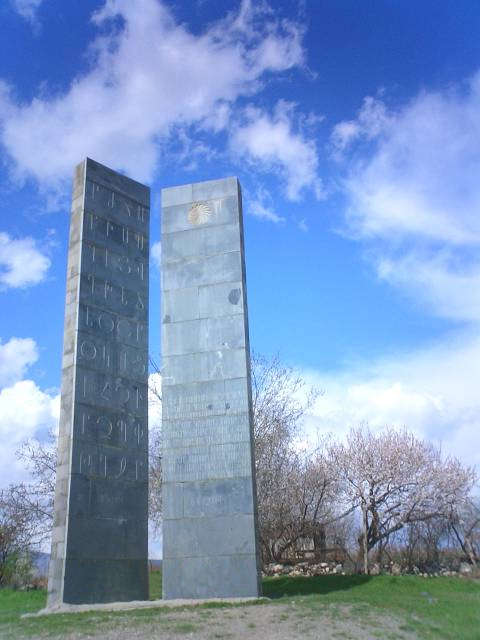
Armenian Alphabet Monument at outskirts
of
Oshakan Village.
Transliteration
The
transliteration system I use is very
simple, based on the Latin character
equivalents assigned to each letter in
the alphabet above. Each letter has an
English equivalent letter, or
combination of letters.
For example, the Armenian
word for
Jacob,
"Հակոբ"
would be pronounced
"Hakob"
in Eastern Armenian, or
"Hagop"
in Western Armenian.
Kalousdian
in Eastern Armenian
Kaloustian
in Western Armenian.
It is important
to remember that the eastern and western
dialects differ in transliteration,
because some Armenian characters are
pronounced differently.
For example, in
Armenian, the equivalent of the English
name
Peter,
is
Petros
in Eastern Armenian, and
Bedros
in Western. As you can see the
P
and the
T
are pronounced
differently in Western Armenian. This
name would be Pedro in Spanish, where
only the letter
T
has changed. This is because the
Armenian alphabet contains a few "middle
sounds" which English has for the most
part lost.
For example, the
P
and
B
sounds have a sound somewhere in between
those two sounds that English speakers
(and often Western Armenians) will have
a very difficult time perceiving. If you
say the English word "sports", you may
notice that you are actually pronouncing
this middle sound without even noticing
it. Most people are not pronouncing a
clean
P,
but something that sounds more like a
B,
but not quite... this is the sound that
Eastern Armenian uses for the second
letter of the Armenian alphabet. Western
Armenians do not use this difference as
much, pronouncing more of a clean
B.
Western Armenian also differs in
vocabulary and conjugation from Eastern
Armenian, which is used in the Republic
of Armenia today.
Dating
Armenian Monuments
Knowledge of the Armenian alphabet is
useful but not essential for
appreciation of Armenia's cultural
patrimony. However, one sure way to
impress on-lookers, including local
worthies, is by deciphering the date on
medieval inscriptions.
Dates are generally marked by the
letters
ԹՎ
or the like, often with a line over,
indicating
"t'vin"
("in the year") followed by one to four
letters, each of which stands for a
number based on its order in the
alphabet. In the Middle Ages, Armenians
used a calendar that started in AD 552
as the beginning of the Armenian era.
To translate into standard years, simply
add 551 to the number. Thus, should you
see an inscription reading
ԹՎ ՈՀԳ,
simply check the alphabet table up and
see that this equals 600+70+3+551= the
year of Our Lord 1224.
TOP
Armenia's
remarkable alphabet
By Ken Gewertz
Harvard University Gazette, MA Nov 3
2005
Saint's sturdy Armenian alphabet focus
of meetings Harvard News Office
In Yerevan,
capital of Armenia, the manuscript
library known as the Matenadaran
possesses an almost sacred status.
Situated on a hill, it is approached by
a long cascade of white marble steps
flanked by statues of the great figures
of Armenian literature. Chief among
these is St. Mesrops Mashtots, who gave
Armenia its alphabet.
According to
James Russell, the Mashtots Professor of
Armenian Studies at Harvard, the
fifth-century saint gave Armenia much
more than an efficient system for
rendering its language into written
form. By means of his invention,
Mashtots gave Armenians a cultural and
religious identity as well as the means
to survive as a people despite the
efforts of larger and more powerful
neighbors to subsume or destroy them.
Armenians pride
themselves on being the first nation to
adopt Christianity, an event that is
supposed to have occurred in the early
fourth century when St. Gregory the
Illuminator succeeded in converting
Trdat, the king of Armenia. But
according to Russell, there is much
evidence that after Trdat's death, the
country was in the process of reverting
to paganism.
"Mashtots'
principal purpose in inventing the
alphabet was to change Armenia's
cultural orientation from the Iranian
East to the Mediterranean West," Russell
said. "He gave Armenia the means and the
incentive to remain Christian."
Having an
alphabet allowed Armenians not only to
translate the Bible into their own
language but works of Christian
theology, saints' lives, history, and
works of classical literature as well.
It also allowed them to develop
scholarly institutions and a literature
of their own.
"Within a
century, Armenians had a library of
classical and Christian learning and
were able to build their own literary
tradition. As a result, they became
independent and almost self-sufficient,
and they became impervious to attempts
by Rome to Hellenize them or attempts by
the Sassanian empire to re-impose
Persian culture on them."
On Oct. 28 and
29,2005, Harvard hosted an international
conference to consider the achievement
of Mashtots, its historical background,
and its wider influence. Organized by
Russell, the conference was sponsored by
the Armenian Prelacy of New York, the
Davis Center for Russian and Eurasian
Studies, and the Department of Near
Eastern Languages and Civilizations at
Harvard. It was held under the patronage
of His Holiness Aram I, Catholicos of
the Great House of Cilicia.
Fortunately for
scholars, Mashtots is known in the
historical record.
One of his
disciples, named Koriun, wrote a
biography of his mentor, which records
many details of his life as well as the
process by which he formulated his
alphabet. The biography tells us that
Mashtots came from an aristocratic
family, that he served in the royal
court, and that he was ordained a priest
and founded several monasteries. With
the support of King Vramshapuh, and with
the aid of a Greek scribe named Ruphanos,
he embarked on a project to develop an
Armenian writing system.
Mashtots
studied various scripts as models,
including Greek and Syriac. He might
also have given careful consideration to
a version of Aramaic script developed by
the Parthian prophet Mani, promulgator
of the gnostic doctrine of Manichaeism.
According to Koriun, Mashtots' synthesis
of all these elements came to him in a
dream, resulting in a 36-character
alphabet. Two more characters were added
during the Middle Ages, bringing the
number of letters in the present-day
Armenian alphabet to 38.
According to
Russell, this synthesis reflects a
deliberate effort on Mashtots' part to
borrow elements from Eastern scripts but
reorient them to give them a more
Western character. All known alphabets
are derived ultimately from the
letterforms of the Phoenicians, but
Eastern writing tends more toward the
horizontal while Western alphabets
emphasize the vertical. Mashtots'
preference for vertical elements
reflects his effort to reorient Armenia
toward the Christian West.
More
information about Mashtots' alphabet has
been gleaned through careful study of
manuscripts. In recent years, computer
analysis has helped scholars to focus
with greater precision on the formation
and evolution of letter shapes. One of
the pioneers in this field, Michael
Stone, professor of Armenian at Hebrew
University in Jerusalem, was the keynote
speaker at the conference. Stone is the
chief author of the recently published
"Album of Armenian Paleography," which
uses computer techniques to analyze the
development of letters over time and is
a great help in accurately dating
manuscripts.
Besides
studying the letter shapes, scholars
have also tried to understand Mashtots'
reasons for ordering the letters as he
did.
Russell, who
has studied this problem and delivered a
paper on the subject, believes that the
order of the letters reflects his
familiarity with number symbolism of the
sort found in a Hebrew text called the "Sepher
Yetsira," or "Book of Creation," thought
to be an early work in the kabbalistic
tradition.
One measure of
the alphabet's success is the fact that
there have been few changes in the
letters or in the spelling of words
since Mashtots created it in the fifth
century.
"This is a very
striking circumstance," Russell said,
"especially when you compare it with
English where spelling has changed a
great deal in just the last 500 years.
It shows that the Armenian alphabet was
already so perfect that there was little
reason for it to change."
Perhaps an even
more convincing argument for the
importance of Mashtots' achievement is
the survival of the Armenian people
through a long and often trying history.
"Mashtots' real
achievement was to create a culture that
became a repository for both Eastern and
Western traditions, that was
cosmopolitan, but had a strong anchor of
its own. He made Armenia a culture of
the book, a 'bibliocracy,' and that has
been their key to survival, because you
can carry a book into exile, but you
can't carry mountains and trees."
James Russell
organized a conference to discuss the
fifth century Armenian alphabet invented
by St. Mesrops Mashtots. Russell said, 'Mashtots'
principal purpose in inventing the
alphabet was to change Armenia's
cultural orientation from the Iranian
East to the Mediterranean West.'
Mesrop Mashtots
Saint Mesrop Mashtots (Armenian: "Մեսրոպ
Մաշտոց", W. Armenian pronounced
Mesrob Mashdots) (360 - February 17,
440) was an Armenian monk,
theologian and linguist. He was born
in Hassik, Taron, Persian Empire
(today's Armenia).
Saint Mesrob is best known for
having invented the Armenian
Alphabet, which was a fundamental
step in strengthening the Armenian
Church, the government of the
Armenian Kingdom, and ultimately the
bond between Armenians in the
Armenian Kingdom, the Byzantine
Empire, and the Persian Empire. He
is also traditionally believed to
have invented the Georgian alphabet
but this belief does not stand up to
scientific scrutiny. In Georgia the
credit is usually given to King
Farnavaz. According to the
Matenadaran, a
monument and museum in Yerevan
dedicated to Mesrob Mashdots, he
also invented the Caucasian Albanian
alphabet and even the Ethiopian one
as well.
He is buried in Oshakan Church, a
village of the same name 8 km
southwest from Astarak_Town.
Oshakan Church
TOP
1875
AD -
Aragatsotn Marz
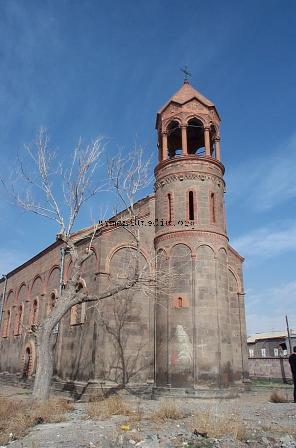
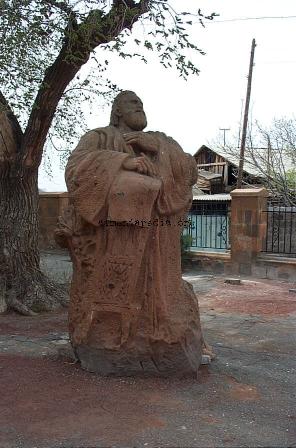
Oshakan Church - where
Mesrop Mashdots is
buried
Mesrop Mashtots statue
in Oshakan Village
Language and Literature
Armenian
literature began to develop with the
creation of the Armenian alphabet in
405-406 A.D. and the subsequent
translation of the Bible into Armenian.
Amongst the first texts to be translated
and studied were those of the great
Greek philosophers, politicians and
theologians. The study of these ancient
thinkers allowed for the
deprovincialization of the Armenian
culture. It also helps to explain why
the first texts written by Armenians are
neither naive nor primitive. One such
early piece was the epic poem "David
of Sasun," celebrating the efforts
of the Armenian bravemen who fought
against Arab domination and for the
freedom of the Armenian people.
The
oldest form of poetry, the hymn of
religious inspiration, has played a
major role in Armenian literature for
centuries. This lyrical poetry, a
combination of poetry and chant designed
for use in religious services, has been
written by the Armenians since the 5th
century.
Religious
lyricism reached its pinnacle in the
10th century with the works of Grigor
of Narek. His masterpiece, the
Narek, is one of the most widely
read works in Armenia.
The
12th century witnessed the rise of yet
another summit of medieval lyricism in
the person of Nerses Shnorhali
(the Gracious). This Catholicos left his
Lamentations on the Fall of Edessa and
many sharakans, or hymns,
used in the Armenian mass. Grigor and
Nerses lived and worked during the
"Golden Age" of Armenian literature as
the art of writing was flourishing. It
was toward the end of this period
(1095-1344) that poetry, including poems
on love and other secular themes, began
to appear and grow as an important force
in Armenian literature.
In the 13th and
14th centuries, Constantine of Erznka
began to write poetry of spring, love,
light and beauty, images which he
allegorically exalts the great mysteries
of Christianity. In Constantine one can
see a broadening of the poetry, a
movement away from more rigid
ecclesiastical terminology and toward a
freer, more open use of language.
In the 15th and
16th centuries, love poetry came to
exist in Armenia. Basically common to
all Eastern literatures, love poetry and
its forms were recreated in Armenia, a
country that had no such tradition
behind it. Nahapet K'utchak
embodied this new movement in poetry.
This new
poetic form continued to the time of
Sayat Nova. This greatest of writers
composed in Armenian, Azeri and
Georgian, singing of courtly love and
the unattainable beauty of the beloved.
The
death of Sayat Nova, in 1795, came on
the brink of the modern era. At this
time in history, the world was becoming
increasingly integrated. Armenian
children were being educated in the
universities of Europe. A new spirit
emerged, a lay spirit. Works once
thought to be vulgar, written in the
laic tongue of the commoner, finally
attained the dignity of literature. New
genres such as the novel, the ballad and
the short story were born as Armenians
were affected by the currents of
rationalism, symbolism and decadence
encompassing Europe; but, the themes of
these works remained traditionally
Armenian. Authors wrote of the land and
its peasant customs, the coveted
fatherland, and the yearning for
freedom.
The
nineteenth century beheld a great
literary movement that was to give rise
to modern Armenian literature. The
veritable creator of modern Armenian
literature was Khatchatour Abovian
(1804-1848). Abovian was the first
author to abandon the classical Armenian
and adopt the modern for his works, thus
ensuring their diffusion. Abovian's most
famed work, The Wounds of Armenia,
returns to the theme of the Armenian
people's suffering under foreign
domination. Khatchatour Abovian
dedicated his life to writing and
educating others on the subject of
Armenia and her people.
The
Armenian national movement was given
impulse by yet another great writer.
Raffi (Hakop Melik-Hakopian) was the
grand romanticist of Armenian
literature. In his works, Raffi revived
the grandeur of Armenia's historic past.
In the story "Gaizer," the heroes fight
for the liberation of their people. This
theme of oppression under foreign rule
is also evident in the works "Djelaledin"
and "Khente."
The literary
tradition of Khatchatour Abovian and
Raffi was continued even as Armenia came
under Communist rule. This revival of
tradition was carried out by such
writers and poets as Hovhaness
Toumanian, Yeghisheh Charentz and
the like. This revival took place under
the Communist system, much restricting
the freedom of expression of the
writers.
In the late
1960's, under Brezhnev, a new generation
of Armenian writers emerged. As Armenian
history of the 1920's and of the
Genocide came to be more openly
discussed, writers like Paruir Sevak,
Gevork Emin and Hovhanness Shiraz
began a new era of literature.
Today
literature thrives in the Republic of
Armenia as well as in the Diaspora.
Writers use one of two standardized
vernacular dialects, Westerns
Armenian and Eastern Armenian,
whose names reflect their geographic
origins.
Throughout centuries of foreign
domination the retention of the Armenian
language seems to have been one of the
people's greatest defenses against
assimilation. It is difficult to express
the deep feeling Armenians have for
their language, which many regard as the
lifeblood of their culture.
TOP
Back to
Matenadaran ‘‘manuscript
store’’
Copyright © 1996-2005 Atlas of
Conflicts, Andrew Andersen. All rights
reserved. |
